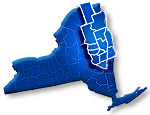|
Distance Learning Course Description
COURSE NAME: Calculus
(SUPA) MAT 295
SCHOOL DISTRICT: Gloversville
INSTRUCTOR:
FULL YEAR:
COURSE PREREQUISITES: Students who elect to enroll
in the course sequence should have completed four years of high school
mathematics.
BRIEF COURSE DESCRIPTION / OUTLINE: MAT 295-296 is the first-year
calculus sequence required of all
science and engineering majors at Syracuse University. MAT 295 comprises
the first four credits of this
eight-credit sequence. The development of scientific calculators with
graphics capability has made possible
some significant changes in the way this material is taught, and many
colleges and universities are now
incorporating them in their calculus sequence. In sections of calculus
offered off-campus through Project
Advance and in selected campus sections, design changes have been
made to integrate these calculators
into the learning process. The course design allows for some variations
in pacing, as determined by site
instructors and the supervising faculty.
The mathematical content of this program is typical
of most traditional first-year calculus courses. The
concepts of limit, continuity, derivative, and anti-derivative and
definite integral are developed in the usual
way, and then applied to the traditional collection of functions:
polynomial, rational, trigonometric, and
exponential, together with their inverses, compositions, and algebraic
combinations. The results are then
applied to a wide variety of problems from geometry, physics, and
other sciences. These include maximum
and minimum problems, related rates, areas, volumes and surfaces of
revolution, arc length, work, fluid
pressure, velocity and acceleration, and exponential growth and decay.
Curve sketching is introduced at the
very beginning and emphasized throughout, as we believe strongly that
this is an important skill for any
calculus student to acquire. Graphing calculators are a help here,
since they contribute substantially to an
understanding of the functions being sketched. They are only a help,
however; the calculators are not used
as a substitute for the skill itself.
During the course students are introduced to progressively
more sophisticated programming techniques for
the calculator. They are shown how to write programs first for the
evaluation and tabulation of functions,
and then for numerical evaluation of limits, derivatives, and roots
(the last by Newton's Method). Students
then learn to do finite sums, Riemann sums, and finally numerical
integration (by Simpson's Rule). Programs
are stored in the calculator as they are written and are used throughout
the course.
1/16/08
|

